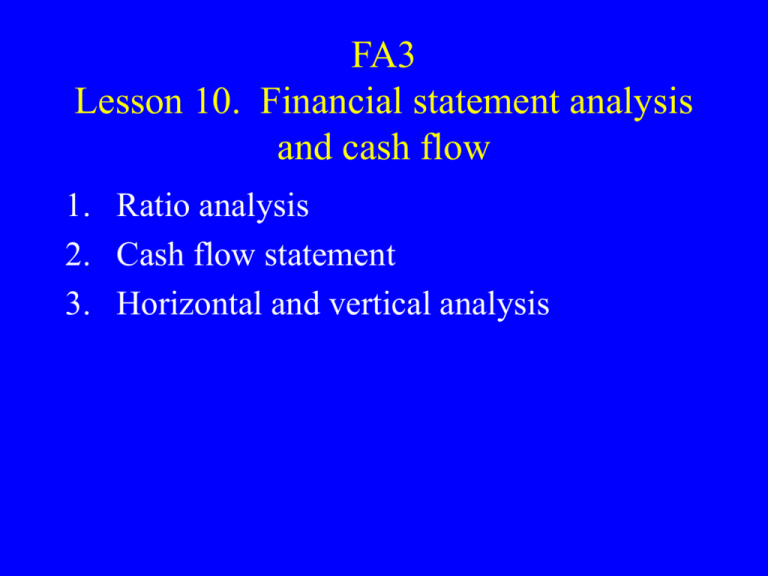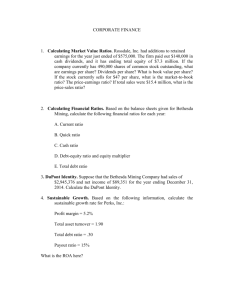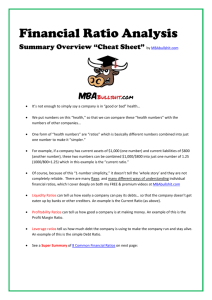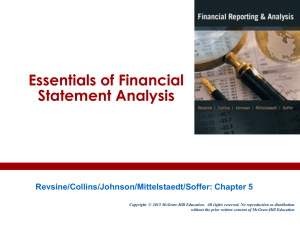9.201 Day 9. Accounting changes
advertisement

FA3 Lesson 10. Financial statement analysis and cash flow 1. Ratio analysis 2. Cash flow statement 3. Horizontal and vertical analysis 1. Ratio analysis Comparison of proportional relationship between two different financial statement items. This removes the effect of size differences between companies, or for the same company over time: • Facilitates comparisons (inter-company and temporal) • Provide informed basis for decision-making • Etc. Problems with ratio analysis • Ratios are only as good as the numbers in the calculations • Ratios are only meaningful if there is a clear understanding RE: the relationship between the numerator and denominator • Ratios require a basis for comparison (benchmarks) • Ratios point out potential problem areas, but usually do not give definitive answers • Ratio results depend on accounting decisions Types of ratios a. b. c. d. Profitability ratios Activity ratios Solvency ratios Liquidity ratios a. Profitability ratios General form = Income/Average Investment, Where Income = net income, EBIT, EBITDA, Income + interest after tax, Net income – preferred dividends, . . . Investment = Shareholders’ equity, Assets, Shareholders equity + long-term debt, . . . The numerator and denominator must be logically consistent. “Average” investment? Use average investment in profitability ratios so that numerator and denominator are based on the same time period. Income is earned throughout the period (usually year), but investment is measured at one point in time. Ideally, average investment for the year= (Investment, Jan 1 + Investment, Jan 2... +.. Dec 31) 365 Practically, the best possible measure is usually Investment, Jan. 1 + Investment, Dec. 31 2 Leverage effect ROE = Income/Average shareholders’ equity ROA = Income + Interest expense after tax Average assets Int. exp. after tax = Int. exp. X (1 – tax rate) ROE – ROA = Effect of leverage This measures additional return to shareholders generated by effective use of debt (borrowing at a low rate to invest in high return projects) Example: Safety Ltd. vs Leverage Safety Leverage Ltd. Average assets (A) Average liabilities (L) Average equity (E) Sales Operating expenses Interest expense (I) Income tax [Rate (R)=33%] Net income (NI) Int. after tax [IAT=(1-R) X I] ROA [(NI+IAT)/A] ROE [NI/E] ROE – ROA (leverage effect) $200 $200 $100 70 10 $20 0 10% 10% 0 $200 150 50 $100 70 15 5 $10 $10 10% 20% 10% Components of profitability ratios Du Pont formula ROA = operating margin X asset turnover, where ROA = EBIT/average total assets, Operating Margin = EBIT/Revenue, and Asset turnover = Revenue/Average total assets. Companies can earn high ROA by combining high turnover and low margin, or by combining low turnover and high margin. b. Efficiency ratios Asset turnover = Revenue/Average Assets AR turnover = Credit sales/Average AR Average collection period = 365/AR turnover Inventory turnover = COGS/Average inventory c. Solvency ratios Debt-equity = Debt/Invested capital Debt = liabilities, long-term debt, . . . Invested cap. = total assets, shareholders’ eq., . . . Times interest earned = Net income + interest exp + income tax exp Interest expense d. Liquidity ratios Current ratio = Current assets/Current liabilities Quick ratio = Monetary current assets Monetary current liabilities Defensive-interval ratio = Monetary current assets Annual operating expenditures/365 2. Cash flow statement EXAMPLE: A23-22 T-account approach (see Beechy and Conrod, chapter 5 appendix, pp. 219 – 223) 3. Horizontal and vertical analysis Horizontal analysis involves recasting financial statements, using prior years’ data as a yardstick. Items are presented as a percentage of the equivalent item in the base (usually oldest) year. Vertical (or common size) analysis involves recasting each of the financial statement items as a percentage of some base item in the same year. The base is usually net sales for the income statement and total assets for the balance sheet. EXAMPLE: A23-3 – vertical and horizontal analysis of A23-22 balance sheet











